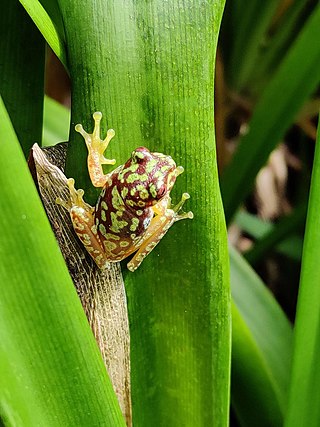
Cochranella nola is a species of frog in the family Centrolenidae, the glass frogs, so named because of the transparent skin on the underside of the abdomen through which the internal organs can be seen. This species is endemic to Bolivia where it is found in the Andean foothills in the Santa Cruz Department. Its natural habitats are subtropical or tropical moist montane forests and rivers. The scientific name nola is Latin for "small bell", and refers to the high-pitched, bell-like call of the male in the breeding season.
Leucostethus argyrogaster or the Imaza rocket frog is a species of frog in the family Dendrobatidae. It is endemic to Peru.
Leucostethus brachistriatus is a species of frog in the family Dendrobatidae. It is endemic to Colombia and occurs on the western slopes of Cordillera Central and on Cordillera Occidental. Common name stripe-throated rocket frog has been proposed for it.
Hyloxalus edwardsi is a species of frogs in the family Dendrobatidae. It is endemic to the Cordillera Oriental in the Cundinamarca Department, Colombia.
Hyloxalus exasperatus or the Yapitya rocket frog is a species of frog in the family Dendrobatidae. It is endemic to Ecuador and found on the eastern slopes of the Andes in Pastaza and Morona-Santiago Provinces. However, it is suggested that specimens from Pastaza represent a different, possibly undescribed species.
Leucostethus fugax, also known as Pastaza rocket frog, is a species of frog in the family Dendrobatidae. It is endemic to the eastern slopes of the Cordillera Oriental, southern Ecuador. Although originally only known from the valley of Pastaza River, it is now known to be more widespread. Its known range extends close to the Peruvian border and its true range may include Peru.
Hyloxalus fuliginosus or the Quijos rocket frog is a species of frog in the family Dendrobatidae. It is endemic to Ecuador where it is known from the Amazonian slopes of the Andes in the northern Ecuador, with some sources reporting it from Colombia and Venezuela.
Hyloxalus idiomelus is a species of frogs in the family Dendrobatidae. It is endemic to the northern part of the Cordillera Central of northern Peru.<
Colostethus imbricolus is a species of frog in the family Dendrobatidae. It is endemic to Colombia.
Colostethus latinasus is a species of frog in the family Dendrobatidae. It is known from Cerro Pirre in Darién Province, Panama, from Chocó Department in adjacent Colombia, and from Tierralta, Córdoba Department, Colombia.

Allobates marchesianus, also known as the dull rocket frog, is a species of frog in the family Aromobatidae. It is found in the Amazon Basin in Brazil, Colombia, Ecuador, Peru, and Venezuela. However, this species might represent a cryptic species complex, where at least the populations from Venezuela belong to an undescribed species.

Colostethus panamansis, also known as the Panama rocket frog or (ambiguously) common rocket frog, is a species of poison dart frog. It is found in northwestern Colombia and Panama. It is one of the best studied poison dart frogs; however, until 2004 Colostethus panamansis was considered a synonym of Colostethus inguinalis, and consequently the older literature uses that name.
Silverstone's poison frog is a species of frog in the family Dendrobatidae endemic to Peru. Its natural habitats are subtropical or tropical moist lowland forests and rivers.

The Sierra Juarez brook frog is a species of frog in the family Hylidae endemic to Mexico. Its natural habitats are subtropical or tropical moist lowland forests, subtropical or tropical moist montane forests, and rivers. It is threatened by habitat loss and possibly by chytridiomycosis, and the IUCN has assessed its conservation status as near threatened.

The Copan brook frog is a species of frog in the family Hylidae found in northeastern Guatemala and northwestern Honduras, specifically in the Sierra del Merendón, Sierra de Omoa, Sierra de Caral, and Sierra Espíritu Santo ranges. The colouring of this species is very distinctive and the specific name soralia comes from the resemblance of its markings to the vegetative structures on some crustose lichens.
Hylodes regius, also known as the royal tree toad, is a species of frog in the family Hylodidae. The specific name regius is not explained in the original species description but probably refers to the yellow and purple-red markings in male Hylodes regius. It is endemic to the Itatiaia Mountains in Minas Gerais, Brazil. After more than three decades without observations, it was detected again in 2012.

The Oregon slender salamander is a species of salamander in the family Plethodontidae from the Northwestern United States.
Platymantis indeprensus is a species of frogs in the family Ceratobatrachidae.

Leptomantis angulirostris, commonly known as the masked tree frog, is a member of the tree frog family Rhacophoridae and is found in Indonesia and Malaysian Borneo. Its natural habitats are subtropical or tropical moist lowland forests, subtropical or tropical moist montane forests, and rivers. It is threatened by habitat loss.
Hyloxalus aeruginosus is a species of poison dart frog endemic to Peru.







